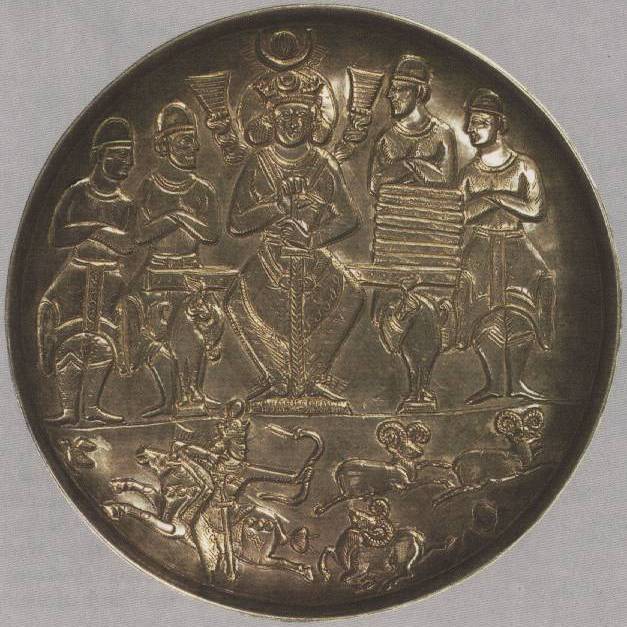|
|
Strelka dish
Plate of Khusrau I with his Court, 6th century AD

A larger image of the Strelka dish, Sassanid Plate of Khusrau I with his Court, 6th century AD, Hermitage Museum S-520
Image Source
Arthur Upham Pope (ed.), A Survey of Persian Art, vol. IV, New York, 1938, Pl. 239A, Plate of Khusrau I with his Court, VI century A.D., Hermitage Museum.
Referenced in Elsie Holmes Peck, "The Representation of Costumes in the Reliefs of Taq-i-Bustan."
Artibus Asiae, Vol. 31, No. 2/3, 1969, Fig. 11.
'a plate of the sixth century A.D. in the Hermitage Museum depicting Khusrau I enthroned with officials of his court.
The nobles wear a robe which forms an arc in front and drops down near the sides but rises again immediately (Fig. 11).
The lowest points of the garment, as shown by the contour of the border, are not pointed but rounded thereby relating the costumes of this plate in the Hermitage Museum very closely to the garments worn by the chief elephant riders at Taq-i-Bustan.'
Fig. 5 in "The Painted Vase of Merv in the Context of Central Asian Pre-Islamic Funerary Tradition" by Matteo Compareti in The Silk Road, Vol. 9 (2011)
One interesting object is the so-called Strelka dish now in the Hermitage Museum Inv. No. S-520 [Fig. 5].
Carter mentioned the Strelka dish but without linking it directly with the scene on
a piece of metalwork from the British Museum that was the object of her discussion about court scenes and Nawruz [Fig. 6].
In fact, both those dishes present a central scene divided into two parts, one above and one below.
This does not seem to be a formula employed for metalwork produced for the central Sasanian court.
While in the British Museum dish, the two sectors of the central part depict courtly scenes,
the Strelka dish also includes a hunting scene in the lower part [Fig. 7].
The two dishes do not appear to be products attributable to a central Sasanian context —
meaning they are probably not from Fars or Mesopotamia.
They are more likely to be eastern Iranian.
According to Prudence Harper and Boris Marshak,
the British Museum dish should be attributed to the Kushano-Sasanians and the Strelka dish to the same region,
though a different period — the 5th to 6th century CE.
|